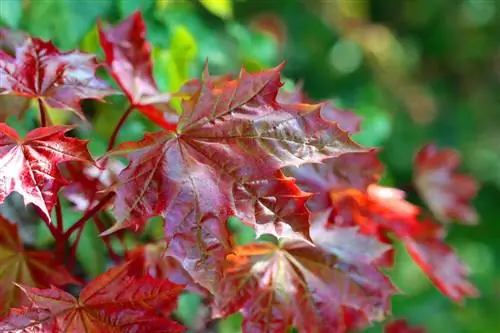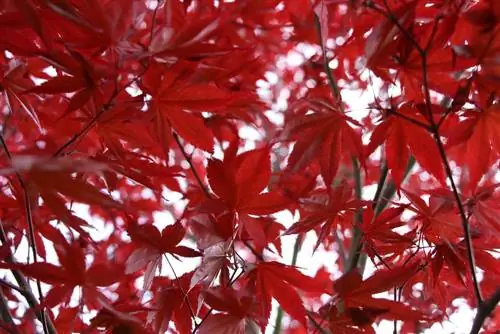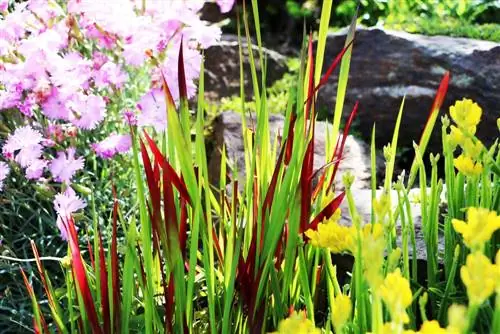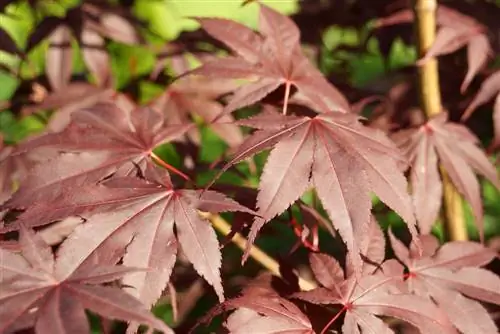- Author admin [email protected].
- Public 2023-12-17 03:39.
- Last modified 2025-01-24 12:45.
The blood maple (Acer platanoides) is originally native to the forests of East Asia. The intense reddish color of the leaves, which decorate the tree throughout the year, has contributed to its great popularity.
Blood maple profile
- Growth height: ten to fifteen meters
- Gender: unisexual
- Type of pollination: cross-pollination
- Leaves: summer green
- Leaf shape: five to seven times lobed
- Leaf color: red
- Flowering period: April to May
- Flower shape: umbels
- Fruit ripening: October
- Fruit shape: split fruit
Location Requirements
Acer platanoides makes very few demands on its location, so it can be planted in almost any habitat. It prefers a sunny to semi-shady location in a position protected from the wind. When it comes to selecting the right soil substrate, there are only a few special features to consider. It also impresses with its high lime tolerance and low nutrient requirements. The density of the soil should not be too high, but rather have a clayey to sandy and permeable consistency.
Note:
Did you know that the blood maple is one of the most popular solitary trees in this country?
Use and plant partner
Due to its striking red leaf color, the blood maple stands out for a prominent position in the garden. Furthermore, growing plant partners in the immediate vicinity is not recommended given the height and width of growth as well as the sprawling root system.
Note:
If you don't have the space in your garden to plant a blood maple outdoors, you can also cultivate it in a bucket or install a root barrier in the ground.
Planting
The blood maple can be planted throughout the frost-free period. However, the best planting time is spring, as this gives the tree enough time to grow and thus develop greater resistance to frost. Seedlings planted later in the year require separate frost protection for the winter.
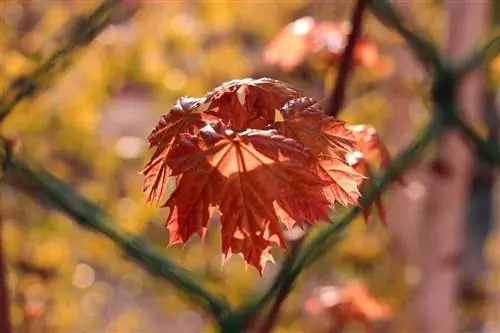
The pot ball should be placed in a hole that is not too large, so that about one to two centimeters sticks out. Sufficient watering of the plant is then necessary to support root growth. It is also possible to integrate a support post to stabilize the young plant.
Tip:
If you want to accelerate the growth of your seedling, we recommend planting it together with horn shavings.
Propagation
There are two options available for propagating the blood maple: propagation by cuttings or by sowing. When propagating from cuttings, a young shoot is removed from the tree that does not yet have excessive woodiness and is a maximum of 20 centimeters long. This is planted in a substrate mixture containing root powder to stimulate root formation. After expulsion, the young plant can then be cultivated in another container or outdoors.
When reproducing via sowing, the following steps must be observed:
- Collecting fruit to ripen in autumn
- Drying the fruits and the seeds they contain over the winter
- Stratify seeds in spring by moisture and cold
- Sowing after the frost period in pots or outdoors
Tip:
The blood maple often reproduces itself in the home garden by sowing. So keep your eyes open for young plants around your tree.
Pouring routine
Acer platanoides is a shallow-rooted plant, so the root area dries out quickly, especially in the warm summer months. Accordingly, it is necessary to ensure adequate watering, which can be supplemented by additional measures such as covering the roots with mulch. The mulch fulfills two protective mechanisms in particular: on the one hand, it prevents excessive evaporation of moisture from the layers of the earth and, on the other hand, it prevents the sensitive root shoots from burning. However, care should be taken when waterlogging occurs, as this can lead to rotting processes. This often occurs in the rainy months or when growing in pots. Therefore, the following instructions should be observed in particular when cultivating in containers:
- Provide pots with draining holes
- Avoid coasters if possible or empty them regularly
- Examine the soil with your finger to a depth of three centimeters
Fertilize
Since the tree prefers nutrient-poor soils, continuous fertilization is not necessary. For young plants, it is still recommended to give horn shavings, compost or other organic fertilizer in spring. In addition, fertilization may prove necessary if growth slows or the leaf crown develops irregularly.
Tip:
Pay particular attention to preventing over-fertilization of the tree. When it comes to fertilization, blood maple should be used sparingly to avoid increased susceptibility to disease or pest infestation.
Cut
The blood maple, like its related maple genera, tolerates pruning very poorly. This is essentially due to the high sap flow, which can cause the tree to bleed if cut excessively. However, with the right timing, this risk factor can be significantly reduced, since as part of the regular growth cycle, the sap pressure continuously decreases in the fall of each year until it dries up completely during the frost period. Basically, pruning serves to thin out the tree crown, as it would otherwise wither excessively in the inner area.
- Only use clean, preferably sterile tools for cutting
- Preferably remove dry branches
- Shortening branches that are too long by a maximum of 50 centimeters
- Carry out maintenance pruning every two years at the latest
Wintering
Acer platanoides is generally very hardy, but young plants and specimens grown in pots still require additional frost protection. Mainly the sensitive root area should be protected with breathable materials such as leaves, brushwood, jute or raffia. For potted plants, the pot itself should also be protected with Styrofoam to protect the substrate from frost damage.
Care errors
Too much water
If your blood maple has dried leaves and shoots, this is mainly due to errors in care due to excessive or too sparing watering or too much fertilizer. By examining the surrounding earth surface and layers, any moisture problems can be quickly identified. Therefore, if the soil is too dry, provide additional watering and, conversely, if the soil is moist, refrain from adding more liquid.
Overfertilization
Despite the low nutrient requirements that the blood maple has, over-fertilization can lead to malformations in the branches and leaves, as the enormous amount of substances it contains inhibits growth. It is therefore advisable to use nutrients only rarely, especially in spring, and to avoid them for the rest of the year if possible.
Selection of location
Another cause of an unsightly appearance could also be the choice of location for the tree. If you choose a location that is too shady, the plant will not be able to develop strong and powerful shoots and leaves. In this case, only a new location change to a sunnier spot can help.
Tip:
A change of location should always be the last measure to be taken with a sick tree, as this represents an additional burden on the plant.
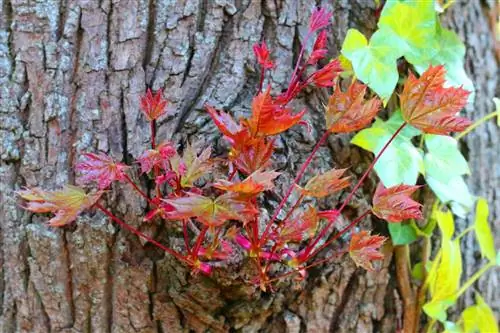
Diseases and pests
Wilting Mushroom
The blood maple is particularly susceptible to fungal diseases, which penetrate the tree through injuries to the bark. A widespread species is the wilt fungus, also known as Verticillium wilt, which is a disease that is currently incurable. The main characteristic is the drying of leaves and twigs. Since no effective fungicide currently exists, the options for treating wilt fungus are very limited. If the symptoms are recognized in time, the affected regions can be removed using a generous excision. If the fungal concentration in the remaining tree regions is not yet too high, there is a chance that these areas will survive. In addition, you should make sure not to keep the soil area around the tree too moist and to keep it well-drained using sand or compost.
Mildew
Mildew is also a fungal disease, but is much less dangerous than the aforementioned wilt fungus. The external appearance of mildew appears as a whitish coating that settles on the leaves. In addition to the use of an appropriate fungicide, a self-made mixture of milk and baking powder in a ratio of 1: 8 has become established in practice, which is sprayed onto the affected areas.
Aphid infestation
Aphid infestation, like powdery mildew, is one of the most common diseases of our native plants. Even if the small animals can hardly be seen by the human eye, the effects of an infestation can be seen even more clearly. As their name suggests, the aphids attack the leaves and extract the vital plant sap from them. This causes the individual leaves to gradually shrivel and curl. If the infestation has not progressed too far, it is often enough to clean the plant of the lice with a strong jet of water. However, the administration of a special insecticide is also recommended.

